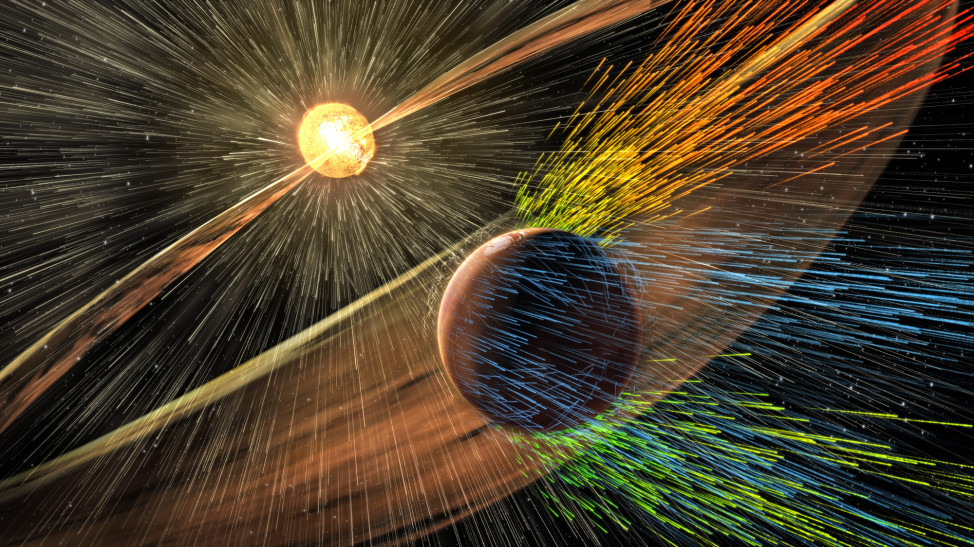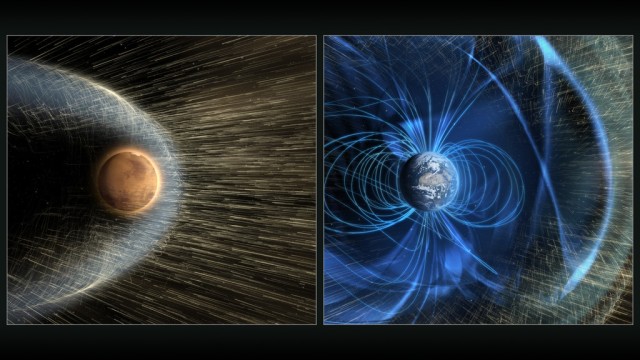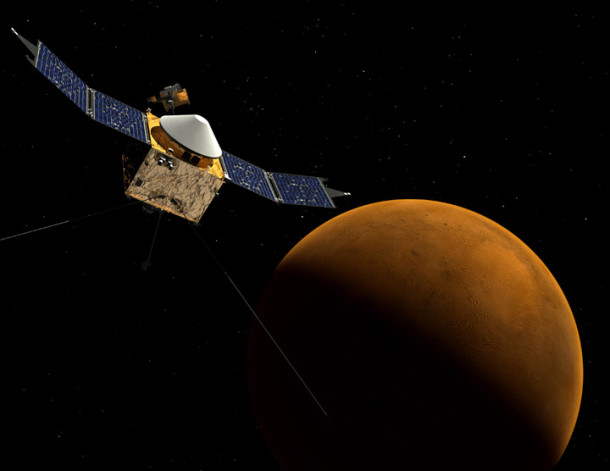NASA’S MAVEN Solves Mars Atmosphere Mystery

Artist’s rendering of a solar storm hitting Mars and stripping ions from the planet’s upper atmosphere. (NASA/GSFC)
Last month NASA dropped a bombshell when it announced it had found evidence of water flowing on Mars.
Yesterday the space agency held a press conference at its Washington headquarters to announce that they may have solved a decades-old mystery of what happened to the Martian atmosphere and its water, when they presented new findings from its Mars Atmosphere and Volatile Evolution or MAVEN mission.
The orbiter has been studying various sections of Mars atmosphere since arriving there in September 2014.
There’s already evidence that suggests at one time early in its history Mars had a thick atmosphere rich in carbon dioxide that kept the planet warm enough to allow for liquid water to flow over its surface.
Back in 2013 scientists at England’s Oxford University revealed that Mars may have also had an oxygen-rich atmosphere about four billion years ago, nearly 1.5 billion years before Earth developed its atmospheric oxygen.

Artist concept of the solar wind interacting with the Mars upper atmosphere (L). But the solar wind is deflected past Earth by its global magnetic field (R) (Credit: NASA/GSFC)
Some previous findings suggest that during this time Mars also had more water than Earth’s Arctic Ocean flowing over its surface.
Scientists generally describe today’s Martian environment as very cold and desert-like.
Michael Meyer, lead scientist of NASA’s Mars Exploration Program summed up what happened to the Martian atmosphere by quoting an old Bob Dylan lyric saying“The answer my friend is blowing in the wind.”
In this case, the wind Meyer is referring to is the solar wind, a stream of highly charged particles that blast from the upper atmosphere of the Sun into the solar system at a speed of about 1,609,344 kilometers per hour with a temperature of about 1 million degrees Celsius.
The MAVEN mission uncovered evidence that the thick Martian atmosphere of its distant past was stripped from the planet billions of years ago by the solar wind, when the sun was young and much more active than today.
NASA says that the solar wind continues to blast away at Mars now thinner atmosphere.
“MAVEN measurements indicate that the solar wind strips away gas at a rate of about 100 grams every second.” Like the theft of a few coins from a cash register every day, the loss becomes significant over time,” said Bruce Jakosky, MAVEN principal investigator at the University of Colorado, Boulder during the press conference.
MAVEN’s findings also revealed significantly more of the Martian atmosphere is stripped away during solar storms.
According to the NASA scientists, the solar wind also carries a magnetic field. As the field passes past Mars, it generates an electric field around the planet in the same way that a turbine can produce electricity here on Earth. This electric field then excites ions, or charged atoms, in Mars’ upper atmosphere and blows them into space.
Data gathered by MAVEN allowed NASA’s scientists to determine how both the solar wind and ultraviolet light takes away gas from the top of the Martian atmosphere.
They found that these ions are stripped away at three different areas of Mars. The first location is down its “tail” where the solar wind streams behind the Red Planet. The second location is at the Martian poles where it forms a “polar plume” of ions. And the third location is from a large cloud of gas that surrounds Mars. According to the scientists, about 75% of the ions that flow away from Mars do so at its tail region, with most of the remaining 25% from the polar plumes. A very small amount of the escaping ions come from the large surrounding cloud.
“Solar-wind erosion is an important mechanism for atmospheric loss, and was important enough to account for significant change in the Martian climate,” said Joe Grebowsky, MAVEN project scientist from NASA’s Goddard Space Flight Center in Greenbelt, Maryland. “MAVEN is also studying other loss processes – such as loss due to impact of ions or escaping hydrogen atoms – and these will only increase the importance of atmospheric escape,” he said.
The new MAVEN mission findings can be found in four new studies that have been published in the journals Science andGeophysical Research Letters.

No comments:
Post a Comment